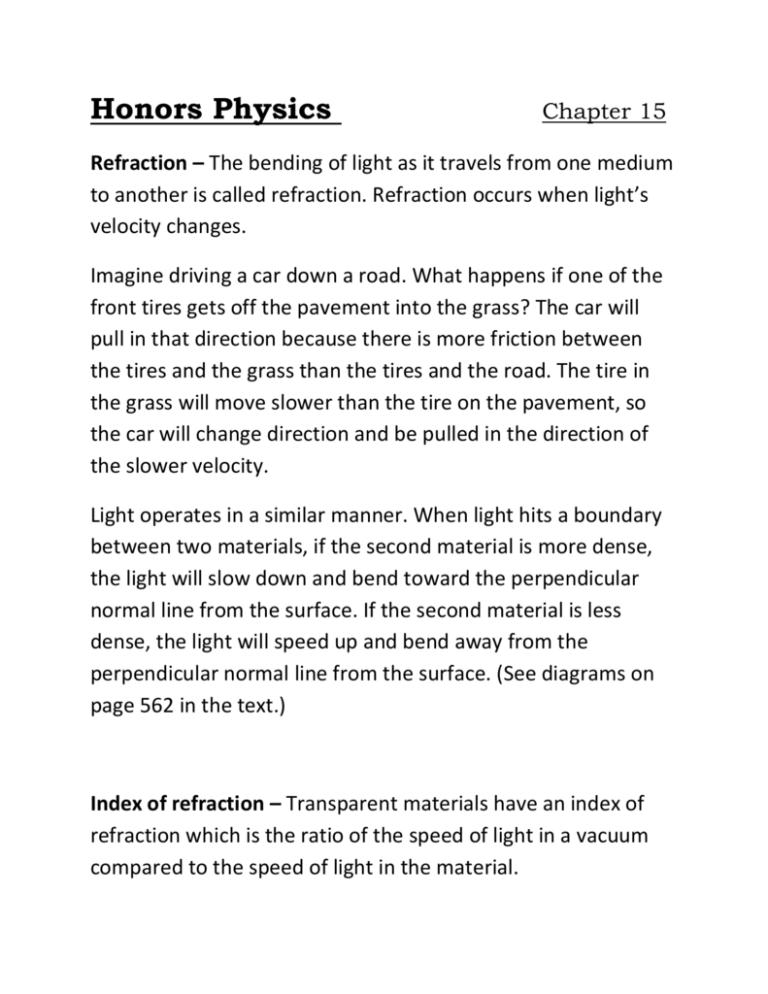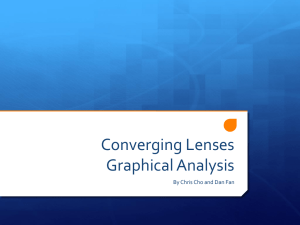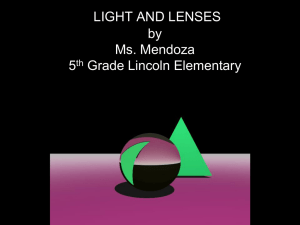Diverging lenses
advertisement

Honors Physics Chapter 15 Refraction – The bending of light as it travels from one medium to another is called refraction. Refraction occurs when light’s velocity changes. Imagine driving a car down a road. What happens if one of the front tires gets off the pavement into the grass? The car will pull in that direction because there is more friction between the tires and the grass than the tires and the road. The tire in the grass will move slower than the tire on the pavement, so the car will change direction and be pulled in the direction of the slower velocity. Light operates in a similar manner. When light hits a boundary between two materials, if the second material is more dense, the light will slow down and bend toward the perpendicular normal line from the surface. If the second material is less dense, the light will speed up and bend away from the perpendicular normal line from the surface. (See diagrams on page 562 in the text.) Index of refraction – Transparent materials have an index of refraction which is the ratio of the speed of light in a vacuum compared to the speed of light in the material. Since the speed of light is faster in a vacuum than any denser material, the index of refraction of any substance will always have a value greater than one. Different materials have different values for the speed of light through the material (partially dependent on density of the substance, but also dependent on the way the molecules of the substance are arranged.) There is a table of values listing the index of refraction for several materials in the text on page 564 to use answering homework questions. Bending of light – As light moves from one medium to another, the light can bend, so when you are viewing an object through another object, the position of the object may not be where it appears. When objects are under water, since water has a higher index of refraction than air, light coming from the submerged object will bend as it leaves the water and enters the air. Light from the object will bend away from the perpendicular because light speeds up when leaving water and moving into air. As a result, objects appear closer to the surface of water than they actually are (see diagrams on page 565.) All bodies of water, and objects in the water, appear shallower than they actually are. Snell’s Law – A formula comparing the index of refraction of two substances and angle of incidence and the angle of refraction is called Snell’s Law: Ni sin Θi = Nr sin Θr Snell’s Law is the way the index of refraction of most materials is first calculated. Once the index of refraction is known, then the speed of light through that substance can be calculated. Practice Problems Page 567 Curved surfaces – When a surface is curved, the perpendicular line changes for different points along the curve. If you have a transparent, curved surface it is called a lens. We will discuss two special types of lenses, converging and diverging. Converging lenses – Converging lenses are thicker in the middle and thinner on the edges. A converging lens takes parallel light rays and brings them together (converging) at the focal point of the lens. The focal distance of a converging lens is positive. Diverging lenses – Diverging lenses are thicker at the edges and thinner in the middle. A diverging lens takes parallel lights ray and spreads them out (diverging) behind the lens. The focal distance of a diverging lens is negative. Images formed by lenses - We will draw ray diagrams, similar to what we did with mirrors, to locate the position and orientation and type of image formed by a lens. For converging lenses: 1. Draw a parallel ray to the principal from the top of the object to the lens, this ray will bend toward the focal point on the back side of the lens. 2. Draw a light ray directly through the center of the lens, which will not bend at all. 3. Draw a light ray through the focal point of the lens to the lens which will bend parallel to the principal axis. Where the rays cross is where the image is formed. If an object is located outside the focal point, a real inverted image is formed. If your object is more than 2 x focal length from the lens, the image is magnified. If you are between one and two focal lengths from the lens, the image is diminished. If the object is exactly two focal lengths from the lens, the image is the same size as the object. If an object is located inside the focal point, a virtual upright magnified image is formed. For diverging lenses: 1. Draw a ray parallel to the principal axis which will diverge away from the focal point. 2. Draw a ray through the center which will continue without bending. 3. Draw a ray through the focal point to the lens which will bend parallel to the principal axis. Where the rays cross is where the image forms. Diverging lenses always produce virtual upright and diminished images. Calculations – Image location can be calculated using the thin-lens formula: 1 / (object distance) + 1 / (image distance) = 1 / (focal length) Image distance is positive if it forms behind the lens. (real) Image distance is negative if it forms in front of the lens. (virtual) Magnification of the image can be calculated using the magnification formula: M = image height / object height = - image distance / object distance Practice Problems on Page 576 Defects in the human eye – When the relaxed eye attempts to produce a focused image on a nearby object but the image is formed behind the retina, the condition is known as hyperopia (farsightedness.) A farsighted person can see objects at a distance clearly, but objects up close are blurred. This condition can be corrected using a converging lens. When the eye is unable to produce a clear image of distant objects, the condition is known as myopia (nearsightedness.) A nearsighted person can see objects up close clearly but objects at a distance are blurry. This condition can be corrected using a diverging lens. Prescription eyeglasses or contacts can be worn to help people with either condition see clearly. Laser eye surgery can also change the shape of the cornea to allow for vision correction for some people, but if the problem is the muscles of the eye and not the curvature of the cornea, laser surgery is not a solution. Total Internal Reflection – Light is bent (refracted) as it passes from one material to another with a different index of refraction. At certain angles the light is bent so much it never leaves the original material and the light is completely reflected. The critical angle can be calculated as follows: sin Θc = nr / ni when the index of refraction of the first medium is greater than the index of refraction of the second medium. (Sine of any angle is never greater than one!) Fiber optic cables are made of glass and take advantage of the property of total internal reflection to transmit electromagnetic signals with practically no loss. Fiber optic cables are used for medical procedures, in electronic devices (optical cable for surround sound for example,) and telephone and cable television in some areas. Refraction in the atmosphere – When air near the ground is hotter than air above it light curves as it nears the ground. Observers can experience a mirage, an image of an object not where the object is actually located. Since the mirage image is inverted, many people assume there must be water on the ground producing a reflection but what they are actually seeing is a refracted image caused by the temperature difference and the blue color they see is actually the sky. Dispersion – The process of separating light according to its wavelength is called dispersion. Different wavelengths are bent different amounts by diffraction, so separation is possible using prisms, water droplets, or basically any material with a different index of refraction than air. Rainbows are formed by dispersion of light into its separate colors by water droplets falling in the air. Shorter wavelength radiation is bent more than longer wavelength radiation so the colors are separated. Spherical aberration – For a spherical lens, light rays far from the principal axis are bent to a point different than rays near the principal axis. This type of dispersion is known as spherical aberration (a separation based on curvature of the lens.) Spherical aberration is most often corrected using some type of filter to block light rays refracted from the near the edges of the lens (an f-stop in a camera for example.) Most eyeglasses are cut from a much larger lens so the spherical aberration of the lens can be eliminated and not be seen with the actual eyeglass lens. Chromatic aberration – As with a prism, or a raindrop, lenses can also separate visible light by focusing different colors at different points along the principal axis. To avoid this defect, most optical instruments (telescopes and cameras for example) use a combination of lenses to re-integrate all colors at the same focal point. Homework: Part 1: 1, 2, 4, 7, 10, 13, 15, 17, 18, 24, 25, 39, 41 Part 2: 27, 28, 29, 30, 34, 36, 38, 59







